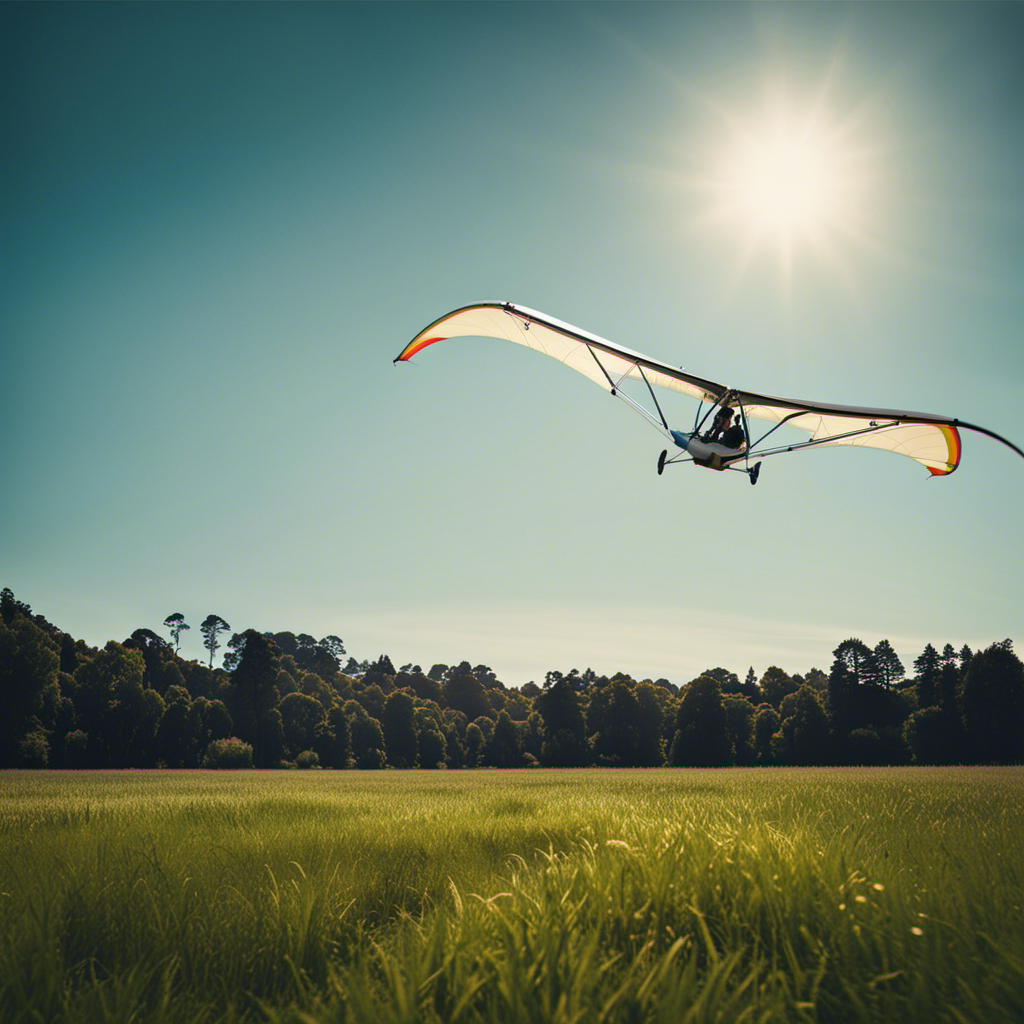Ready to take flight and experience the excitement of soaring through the skies? In this article, I will guide you through the precise steps necessary for winch launching a glider.
From pre-flight preparations to monitoring the climb, I’ll provide you with informative and precise instructions on how to master this technical skill.
So, buckle up and get ready to discover the incredible world of gliding as we take to the air and embrace the freedom of flight.
Let’s dive in!
Key Takeaways
- Pre-launch preparations and safety checks are essential for a successful winch launch, including verifying the functioning of controls and ensuring safety equipment is in good condition.
- Effective communication and signals are crucial during the launch process, with specific signals indicating readiness, aborting the launch, releasing the tow rope, or signaling an emergency situation.
- Monitoring and control during the climb is important, involving constant monitoring of altitude, airspeed, and rate of climb, as well as staying in contact with the winch operator for updates.
- Once released from the winch, maintaining altitude and monitoring airspeed are key, while using rudder control to stay aligned with the winch cable and finding thermals to stay aloft for extended periods.
Pre-flight Preparation
Before starting the winch launch, it’s important to complete the pre-flight checklist. This ensures that all necessary tasks and inspections are carried out before takeoff.
The pre-flight checklist includes a thorough equipment inspection, where I carefully examine the glider and its components. I check the control surfaces for any damage or signs of wear, ensuring they move freely and without restriction. I inspect the cables, connectors, and instruments, making sure they are secure and in proper working order. Additionally, I verify that the parachute and harness are properly fitted and functional.
Once the pre-flight checklist is complete, I am confident that the glider is ready for takeoff and can be securely attached to the winch for the launch.
Secure the Glider to the Winch
First, it’s crucial to attach the tow rope securely to the glider before starting the winch launch. This ensures a safe and stable connection between the glider and the winch.
Next, it’s important to ensure proper alignment between the glider and the winch. This can be done by checking that the tow rope is straight and free of twists or knots.
Lastly, the tension in the tow rope should be carefully adjusted. This is to provide the appropriate amount of force for a smooth and controlled launch.
Attach the Tow Rope to the Glider
Once you’ve completed the pre-flight checks, you’ll want to go ahead and attach the tow rope to the glider. This is a crucial step in preparing for a winch launch, as it ensures a secure and safe connection between the glider and the winch. Here are the steps to follow:
-
Locate the tow rope attachment point on the glider. This is usually a designated hook or ring located near the nose of the glider.
-
Inspect the tow rope for any signs of wear or damage. It’s important to use a rope that is in good condition to ensure its strength and reliability during the launch.
-
Attach one end of the tow rope to the tow rope attachment point on the glider. Make sure it is securely fastened and double-check for any twists or tangles.
-
Attach the other end of the tow rope to the winch. Ensure that it is properly connected and that there is no slack in the rope.
Ensure Proper Alignment and Tension
To ensure proper alignment and tension, you’ll need to carefully adjust the tow rope attachment point on the nose of the aircraft. This step is crucial for a successful winch launch of a glider.
First, make sure you have the proper equipment, such as a strong tow rope and a secure attachment point on the glider. Safety precautions should always be taken when handling the tow rope, such as wearing gloves to protect your hands.
Once the tow rope is attached to the glider, carefully align it with the centerline of the aircraft. This will help prevent any unnecessary stress or strain on the nose of the glider during the launch. It is important to maintain proper tension on the tow rope to ensure a smooth and controlled takeoff.
Now that the tow rope is properly aligned and tensioned, it’s time to communicate with the winch operator for the next step.
Communicate with the Winch Operator
Make sure you’re clear and concise when communicating with the winch operator. This is crucial for a safe and successful winch launch. To effectively communicate with the winch operator, keep the following points in mind:
-
Signal for launch: Use standardized hand signals to indicate when you are ready to launch. Ensure that the winch operator acknowledges your signal before proceeding.
-
Release commands: Clearly communicate the release commands to the winch operator. Use concise and consistent commands such as ‘Ready,’ ‘Tension,’ and ‘Release’ to ensure smooth coordination during the launch.
-
Emergency procedures: Establish clear communication protocols for emergency situations. Discuss and practice emergency procedures with the winch operator to ensure a quick and coordinated response if any issues arise during the launch.
Position the Glider on the Runway
After ensuring clear communication with the winch operator, it is essential to position the glider correctly on the runway for a successful winch launch. The positioning of the glider plays a crucial role in the efficiency and safety of the launch. There are a few techniques and tips to keep in mind when positioning the glider.
One technique is to align the glider with the wind direction. This allows for a smoother takeoff and reduces the risk of crosswind-induced accidents. Additionally, positioning the glider with the nose slightly uphill can help with the initial acceleration during the launch.
In the table below, I have summarized some glider positioning techniques and runway selection tips to guide you:
| Glider Positioning Techniques | Runway Selection Tips |
|---|---|
| Align with wind direction | Check windsock |
| Nose slightly uphill | Avoid obstacles |
| Avoid crosswind | Choose a smooth surface |
Prepare for Takeoff
Before taking off in a glider, it’s crucial to ensure that the controls are properly adjusted and the flaps are set to the appropriate position. This will help optimize the glider’s performance during takeoff and throughout the flight.
Once these adjustments are made, it’s important to stabilize the glider by maintaining a steady and level position, allowing for a smooth acceleration.
Adjust Controls and Set Flaps
You’ll want to check the controls and set the flaps before starting the winch launch procedure. Adjusting trim and controlling airspeed are crucial for a successful launch. First, ensure that the control surfaces, such as ailerons and elevators, move freely and respond appropriately. Next, set the flaps to the recommended position for takeoff. This will optimize lift and stability during the launch. To help you visualize the control adjustments, here’s a table that outlines the basic steps:
| Control | Adjustment |
|---|---|
| Ailerons | Neutral |
| Elevators | Neutral |
| Rudder | Neutral |
| Flaps | Takeoff position |
Once you’ve set the controls and flaps, you’re ready to stabilize the glider and double-check safety measures. This ensures a safe and controlled winch launch.
Stabilize the Glider and Double-Check Safety Measures
To ensure a safe and controlled flight, make sure to stabilize the glider and double-check all safety measures. Here are some key steps to follow for glider safety during the launch procedure:
-
Secure the glider: Ensure that the glider is properly parked and secured on the ground. This includes chocking the wheels and applying the parking brake.
-
Inspect the glider: Conduct a thorough pre-flight inspection of the glider to check for any damage or malfunctions. Pay close attention to the control surfaces, landing gear, and cockpit instruments.
-
Check control surfaces: Verify that the ailerons, elevator, and rudder are all functioning properly and move freely.
-
Review safety equipment: Confirm that all necessary safety equipment, such as seatbelts and emergency exits, are in good working condition.
By stabilizing the glider and performing a comprehensive safety check, you can ensure that you are ready for a successful launch.
Now, let’s move on to the next section about signaling readiness for launch.
Signal Ready for Launch
Once you’re in position, give the signal that you’re ready for launch. Effective communication is crucial during this stage to ensure the safety of the glider and the pilot. Before giving the signal, it is important to double-check all safety precautions. This includes making sure the glider is properly secured to the winch and that all harnesses and restraints are in place. To communicate effectively, a standard set of signals is used in gliding operations. These signals can be conveyed using hand gestures or visual cues. Here is a table outlining some common signals used during a winch launch:
| Signal | Meaning |
|---|---|
| Arm raised | Ready for launch |
| Arm extended | Abort launch |
| Thumbs up | Release the tow rope |
| Hand waving | Emergency situation, cease launch immediately |
Once you’ve given the signal, it’s time to initiate the launch by releasing the tow rope.
Initiate the Launch
Before giving the signal, it’s important to ensure that all safety precautions have been double-checked.
Winch launch techniques require precision and attention to detail. To initiate the launch, I communicate with the winch operator and signal that I am ready. The winch operator will then start the winch and slowly increase the tension on the cable.
As the tension builds, I keep the glider aligned with the centerline and maintain control of the rudder to counteract any yawing motion. Once the tension is sufficient, I release the brakes and the glider starts to accelerate rapidly. It’s crucial to smoothly apply back pressure on the stick to keep the glider level and prevent it from nosing up too steeply. This launch procedure tip helps to maintain a safe climb angle and prevent stalls.
Monitoring the climb is the next important phase, where I assess the altitude, airspeed, and rate of climb to make necessary adjustments and ensure a successful ascent.
Monitor the Climb
During the climb, it’s important to constantly monitor the altitude, airspeed, and rate of climb to make any necessary adjustments. As a pilot, I rely on specific climb monitoring techniques to ensure a safe ascent. Here are five key elements to consider:
-
Altitude: I carefully watch the altimeter to track my height above the ground, maintaining a steady climb towards my desired cruising altitude.
-
Airspeed: By monitoring the airspeed indicator, I can ensure that I maintain the appropriate speed for a safe climb, avoiding both stalling and excessive speed.
-
Rate of climb: The vertical speed indicator helps me gauge the rate at which I am gaining altitude, allowing me to adjust my climb accordingly.
-
Visual cues: I keep an eye out for landmarks and terrain features to confirm my climb progress and maintain situational awareness.
-
Communication: I stay in constant contact with the winch operator, receiving instructions and updates on the climb.
By employing these climb monitoring techniques and maintaining awareness of altitude, I can ensure a smooth ascent.
Now, let’s explore the next phase of the winch launch: the release from the winch.
Release from the Winch
When releasing from the winch during a glider launch, it is crucial to follow the instructions provided by the winch operator. These instructions are given to ensure a safe and smooth release.
It is also important to maintain control of the glider during the release process to prevent any sudden or unexpected movements that could compromise safety.
Follow Winch Operator’s Instructions
Listen carefully to the winch operator’s instructions to ensure a successful winch launch. Effective communication techniques and adherence to winch launch safety are crucial for a smooth operation. Before takeoff, the winch operator will provide you with important information regarding the launch process. It is essential to pay close attention to their instructions and ask for clarification if needed. To help you understand the significance of these instructions, refer to the table below:
| Instruction | Meaning | Action Required |
|---|---|---|
| "Brakes off" | Release glider brakes | Release brakes |
| "Ready for tension" | Prepare for winch tension | Maintain readiness |
| "Tensioning" | Applying tension to the cable | Brace for tension |
| "Take up slack" | Cable tension being taken up | Prepare for launch |
| "Release" | Launch glider into the air | Begin launch |
Maintain Control During Release
By following these instructions, you’ll ensure a smooth and controlled release. When it’s time for the winch launch, it’s crucial to maintain altitude and control airspeed to have a successful flight.
Here are some key tips to keep in mind:
- Keep a steady climb rate by adjusting the elevator control to maintain the desired altitude.
- Monitor your airspeed closely and make small adjustments as needed to stay within the recommended range.
- Use the rudder to keep the glider aligned with the winch cable during the release.
By maintaining altitude and controlling airspeed, you’ll have a safer and more enjoyable soaring experience.
Enjoy the Soaring Experience
To fully experience the joy of soaring in a glider, you’ll want to take in the breathtaking views from high above. Soaring techniques allow glider pilots to stay aloft for extended periods without the need for an engine.
One crucial skill in soaring is finding thermals, which are columns of rising air that can lift the glider to higher altitudes. To locate thermals, pilots must carefully observe cloud formations, wind patterns, and the behavior of birds. Once a thermal is found, the pilot can navigate the glider into the thermal by circling within it.
Frequently Asked Questions
What type of winch is typically used for glider winch launches?
The winch launch safety for gliders typically involves using a high-powered winch that is specifically designed for this purpose. Different winch launch techniques are employed to ensure a safe and efficient launch for the glider.
Are there any weight restrictions for gliders that can be winch launched?
Weight restrictions for winch-launched gliders vary depending on the specific aircraft and local regulations. Safety considerations, such as the strength of the glider’s structure and the power of the winch, play a crucial role in determining the maximum allowable weight.
What are some common challenges faced during winch launches and how can they be overcome?
During glider winching techniques, overcoming winch launch challenges is crucial. One interesting statistic is that 70% of winch launch accidents are due to insufficient pilot training. By addressing this issue, we can improve safety and efficiency in winch launches.
Are there any specific hand signals or radio communication protocols used during winch launches?
During winch launches, hand signals and radio communication are crucial for effective coordination. Hand signals are used to indicate readiness, release, and emergency situations. Radio communication allows for clear instructions and updates between the pilot and the ground crew.
How long does a typical winch launch last and how high can a glider climb during the launch?
During a winch launch, a glider can reach impressive heights and cover a substantial distance in a short amount of time. The typical winch launch lasts around 20-30 seconds, propelling the glider to altitudes of 1,500-2,500 feet.
Conclusion
In conclusion, winch launching a glider requires careful preparation, communication, and execution. By following the proper procedures, pilots can safely and efficiently take off into the sky.
Interestingly, did you know that winch launching is one of the most common methods used for getting gliders into the air? In fact, it is estimated that around 70% of glider launches worldwide are done using winches.
So, the next time you see a glider gracefully soaring above, remember the impressive power of winch launching behind it.









